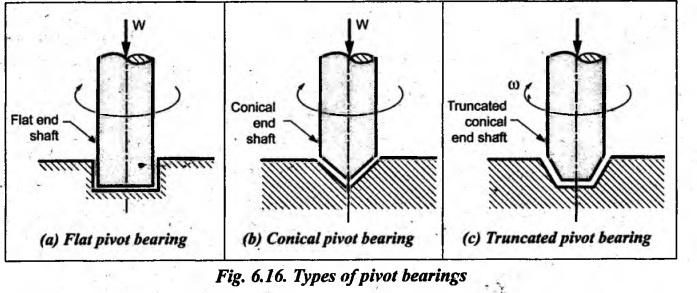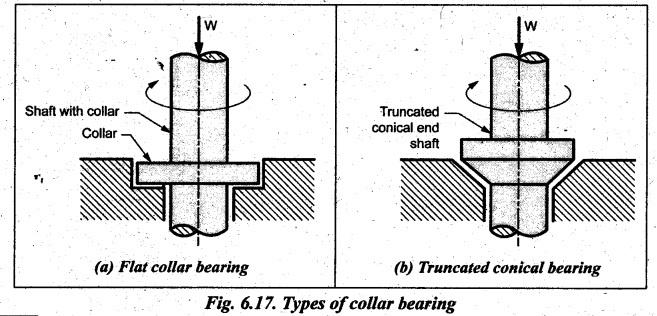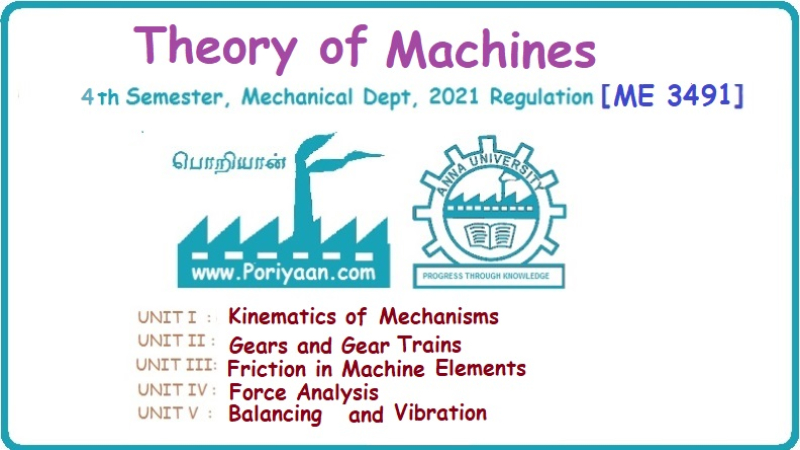Theory of Machines: Unit III: Friction in Machine Elements
pivot and collar friction
Friction in Machine Elements - Theory of Machines
Force acting along the axis of a shaft is known as thrust.
PIVOT AND COLLAR FRICTION • Force acting along the axis of a shaft is known as thrust. The rotating shafts are quite frequently subjected to axial thrust. This axial thrust produces lateral motion along the axis, which is prevented by providing one or more bearing surfaces (called pivots and collars) at right angles to the axis of rotation. • The bearing surfaces provided at the end of a shaft are known as pivots. The pivot may have a flat or conical or trapezoidal surface, as shown in Fig.6.16(a), (b) and (c) respectively. • The bearing surfaces provided at any place along the length of the shaft are known as collars. The collars may have flat bearing surface or conical bearing surface, as shown in Fig.6.17(a) and (b) respectively. Note 1. The collar bearings are also known as thrust bearings. 2. When the bearing is at the end of vertical shaft, it is called foot step bearing. When the rotating shaft conveys its axial thrust to the bearings, rubbing takes place between the contacting surfaces. This produces friction as well as wearing of the bearing. We know that the rate of wearing depends upon the intensity of thrust (pressure) and relative velocity of rotation, but velocity is proportional to the radius. Now there could be two assumptions based on which the bearings can be designed. First assumption: Uniform pressure theory • The intensity of pressure is uniform over the bearing surface i.e., p = constant. • This assumption holds good only for newly fitted bearings and also the fit between the shaft and bearing surfaces should be perfect. Second assumption: Uniform wear theory • The rate of wear is uniform, i.e., p • r = constant. • This assumption holds good for old (used) bearings. • When the bearing becomes old, the bearing surface will worn out and thus the pressure distribution will not remain uniform due to varying wear at different radii. Since the rate of wear Note 1. Though neither of the two assumptions is strictly true, the design of bearings and the calculation of power lost due to friction in pivot and collar bearings are carried out based on the above two assumptions. 2. It will be observed that frictional torque under uniform pressure conditions is greater than that of under uniform wear conditions. Therefore, unless or otherwise specifically stated, whenever power lost in friction has to be determined uniform pressure conditions must be assumed. On the other hand if the power transmitted is to be determined assume uniform wear conditions.1. Introduction


2. Concept of Uniform Pressure and Uniform Wear

 , the pressure will go on increasing radially inward:
, the pressure will go on increasing radially inward:
Theory of Machines: Unit III: Friction in Machine Elements : Tag: : Friction in Machine Elements - Theory of Machines - pivot and collar friction
Related Topics
Related Subjects
Theory of Machines
ME3491 4th semester Mechanical Dept | 2021 Regulation | 4th Semester Mechanical Dept 2021 Regulation
